Steiger
Tractor Company 4wd Tractor Heritage
1958-1989

The Steiger 4wd emerged from the Red River
Valley region nearly 50 years ago. Brothers, Doug and Maurice Steiger,
built the first Steiger in their Thief River Falls, Minnesota dairy barn, during
the winter of 1957-58. Steiger #1 was built from truck components and powered by
a 238 hp Detroit Diesel Engine. The simple and powerful design impressed local
farmers and soon the Steiger brothers were building tractors.
The Steiger 4wds expanded in 1963 to
include a horse power range from 118 hp to 300 hp. They stood out with the
Steiger name plate cut from 3/8-inch steal and the models V-8 engine designation
cut as a large V in the tractors grill. The success of the Steiger is the main feature was standard components. Major parts, such as
engines, transmissions and power trains were outsourced from brand name
suppliers like Caterpillar, Cummins, Allison, Clark and Spicer. Farmers
liked the components because could find replacement parts nation wide.
By the 1970s Steiger 4wds were being
sold nation wide. Grain, vegetable, row crop and dairy farms were all
finding uses for the big 4wds. Steiger 4wds were rolling out of a large
factory in Fargo, North Dakota. Cat names like Wildcat, Bearcat, Cougar,
Panther and Tiger donated the horse power ranges. New styling and power
lead Steiger to the top of the pack with a 36% market share.
1976 was a big year for Steiger with the
introduction of the Series III models. The Series III models offered a new
modern cab and a range of new developments. The horse power range grew up
to 470 hp and Steiger developed the first pto option on an articulated
4wd. By the end of the decade Steiger had produced its 10,000th tractor.
As the Steiger Tractor company entered
the 1980s, the tractors size and popularity had grown beyond anything the
Steiger brothers would have imagined in 1958. In 1983 Steiger introduced
its largest tractor the 525 hp KP-525 and ultra modern Panther 1000
series. The 1000 series was a new 4wd from the ground up. The cab
offered an unmatched view of the field and the new sleek hood design allowed for
a clear line of site for the ground ahead. By 1985 Steiger was
producing 26 tractor models with three engine options, a horse power range from
190 hp for row crop farmers up to 525 hp for the ultimate plowing power.
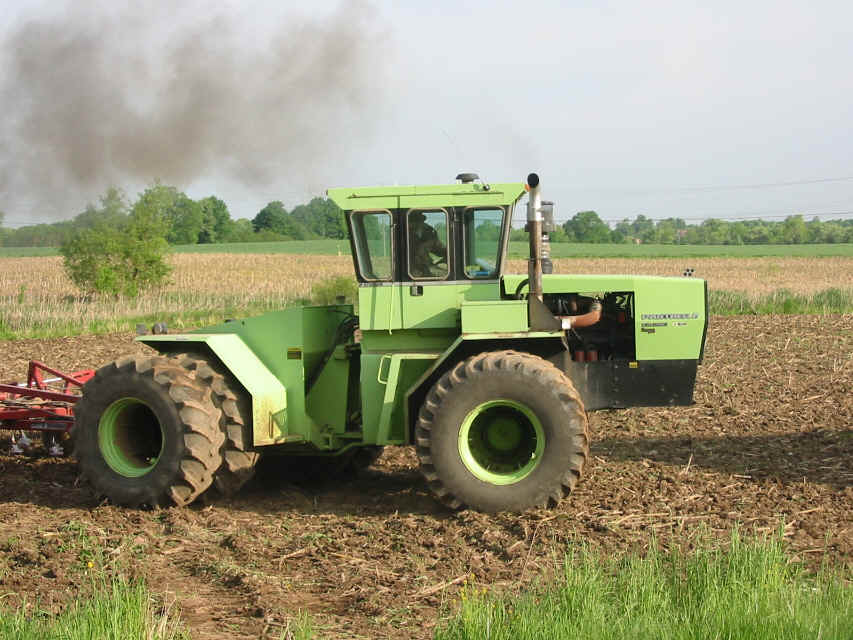 . . |
Steiger in a little over 20 years had
become a legend in farming. Before Steiger, most farmers beyond the parries
could not imagine using an articulated tractor in their operation.
Steigers range of model sizes, horse power, transmissions and treads took 4wd
power coast to coast. The Iowa corn farmer, California vegetable farmer, Kansas
wheat farmer, Arkansas rice farmer, Louisiana sugar can plantation, Texas
rancher and Wisconsin dairy farmer all found a way to incorporate 4wd
power. Steiger 4wds were also a global tractor with models going to
Europe, Africa and Australia.
The Steiger Tractor Company was
unmatched in 4wd choices. Unfortunately the economy of the 1980s did not
allow farmers to afford so many tractor options in the high horse power
class. Sales dropped off and the Steiger factory was only producing at a
quarter of its capacity. In 1986 Steiger Tractor Company was purchased by
Tenneco the parent company of Case. Case continued producing green
Steigers as well as the new 9100 series Case International Steigers. The
Steiger name appeared on green and red tractors until 1989.
Today the CaseIH STX Steiger series is
the market leader in 4wds, with models ranging from 275-500 hp. The
classic green Steigers still account for a large portion of 4wds used in
farming. The Barn Series, Series I, Series II, Series III and 1000 Series
were built to last a life time. Many have 10,000, 15,000 and 20,000+ and are
running as well as the day they rolled out of the factory. Farmers like
Steiger 4wds because they are easy to maintain and use. They represent
power to get across the field and put the crop in quickly.
The Steiger 4wd history below is a
general overview of the Steiger Tractor Company's heritage from 1958-1989.
This section highlights the general history, models and horse power ranges of
the Barn Series, Series I, Series II, Series III, Series IV, 1000 Series and
9100 Series Steigers.
|
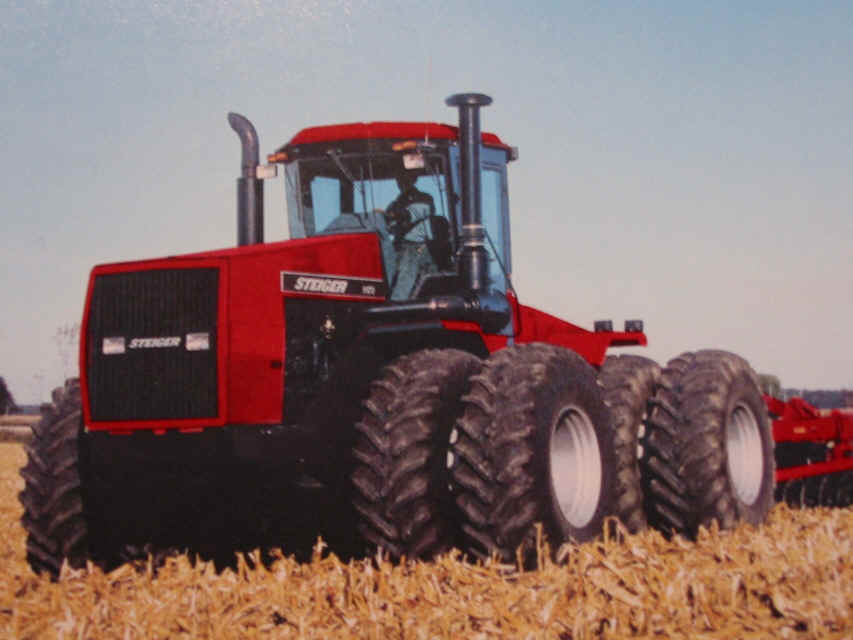
|
Steiger
Tractor Inc. a Subsidiary of J.I. Case
Steiger 9100
Series
Years of Production: 1986-1989
Models:
9110 (190 hp), 9130 (235
hp), 9150 (280 hp), 9170 (335 hp), 9180 (375 hp), 9190 (525 hp)
History:
The poor farm economy took its tool on the Steiger Tractor
Company. With the world farm economy struggling, Steiger
sold fewer tractors. In 1986, with the plant operating at 25% of capacity,
Steiger filed for Chapter 11 bankruptcy protection. Later that
year, Tenneco, Inc. the then parent of J.I. Case, bought Steiger.
In 1985 Tenneco purchased Interational Harvesters Ag Division and formed
Case-International under the J.I. Case Company. Case-IH tractors
took on International's famous Harvester red. With the purchase of
Steiger, Case continued to produce articulated 4wds under the Steiger
name as well as producing the first red Case International 9100 series
4wds. Under Case-IH the Cat names were replaced with numbers: Puma
= 9110, Wildcat = 9130, Cougar = 9150, Panther = 9170, Lion = 9180,
Tiger = 9190. From 1986-1989 customers could purchase a red 9100
series Steiger. In 1990, Case-IH introduced the 9200 series and
phased out the Steiger name. Case returned the Steiger name to the
4wd in 1995 with the 9300 series. The Steiger name plate badge was
placed on the grill and the CaseIH name on the hood decal. Today
the CaseIH STX Steiger series leads the 4wd market in sales and
continues the solid Steiger tradition started in 1958.
|
|
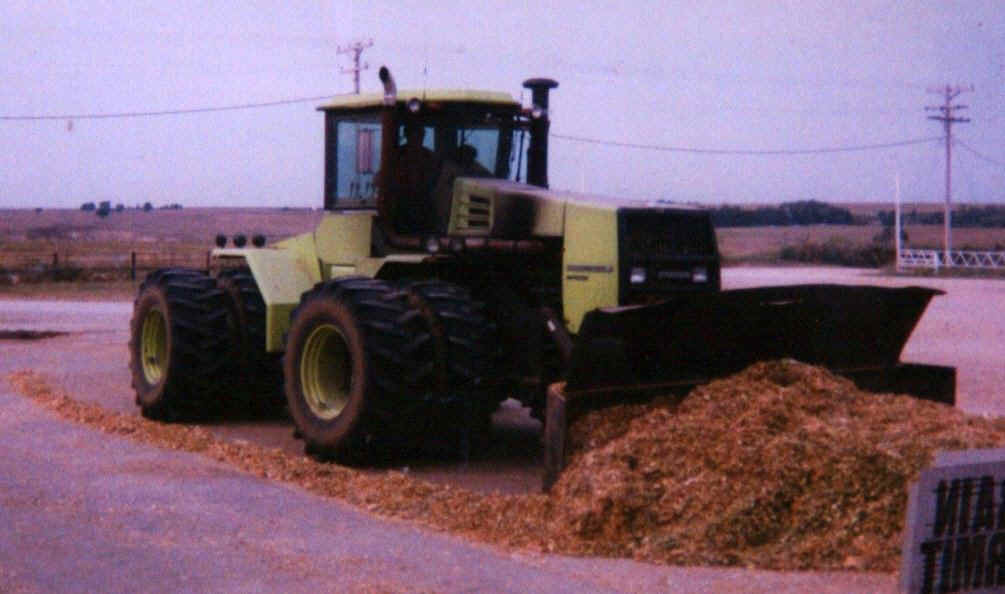
|
Steiger
1000 Series
Years of Production: 1983-1986
Models:
Puma (190 hp) ,Wildcat (220 hp), Cougar ( 225 hp) CR-1225,
KR-1225, Bearcat (235 hp), Cougar (280 hp), Panther (325/360/400
hp) CP-1325, KP-1325, CP-1360, KP-1360, CP-1400, KP-1400, Panther (335
hp), Lion (375 hp).
History:
A new style of Steiger tractor was released in 1983 along with the
series IV. The 1000 series was launched with six new Panther
models. The Panther 1000 models offered a 12-speed full
powershift transmission, on-board computer, and new Safari Cab and
sloped to improve visibility. The Panther 1000 series was produced
along side the series IV models through 1985. The initial Panther
1000 models were ranged from 325-400 hp and were powered by Caterpillar
or Cummins engines. Steiger used CP to mark the Caterpillar engine
Panthers and KP for the Cummins models. In 1985 Steiger introduced
the Cougar 1000 with two 225 hp models. CR was the Caterpillar
model and KR was the Cummins Cougar 1000. Between 1983 and 1985
Steiger was producing 26 different tractors with the Series IV models
and the Panther and Cougar 1000 models. In 1986 Steiger revamped
the entire line and simplified it to 6 models. The 1000 series
accounted for five models. The new Puma and Wildcat 1000 tractors
offered row crop farmers a new modern 4wd. The Bearcat and Cougar
1000 tractors supplied mid-range power. The 6 Panther models were
narrowed down to one 335 hp tractor. The new Lion 1000 topped of
the series at 375 hp.
|
|
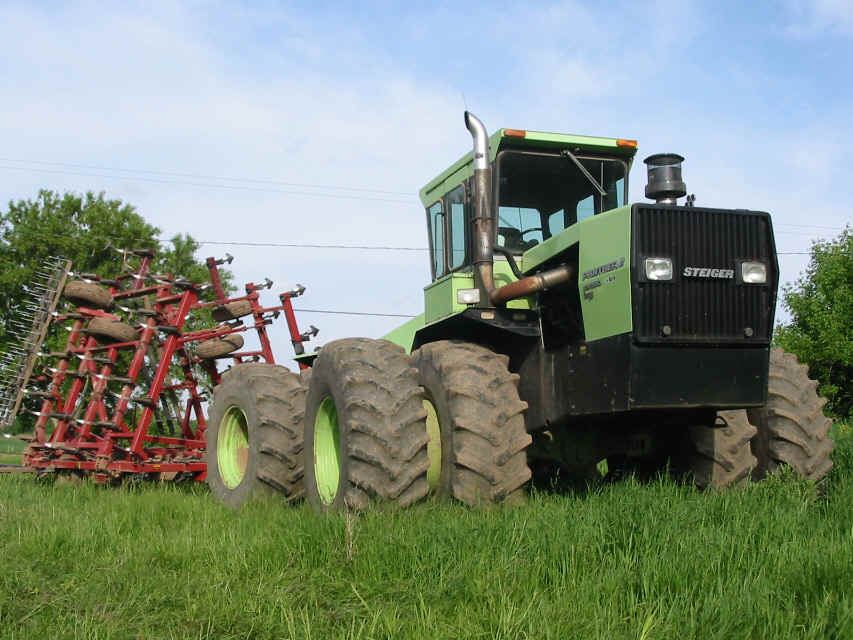
|
Steiger
Series IV
Years of Production: 1983-1985*
Models:
Bearcat (225 hp) CM-225, KM-225, Cougar (250/280 hp) CM-250, KM-250,
CM-280, KM-280, CS-280, KS-280, Panther (325/360 hp) CM-325, KM-325,
SM-325, SM-325, CS-325, KS-325, CM-360, KM-360, CS-360, KS-360, Tiger
(525 hp) KP-525. (* The Tiger IV was produced from
1984-1988 and ended production as the Case International 9190)
History:
The Series IV Steiger 4wds were best of the line that started in 1969
with the Wildcat I. All of the possible refinements and upgrades
had been made. Identification numbers changed on the Series
IV. Caterpillar, Cummins and Komatsu engines were the Series
IV power plants. The Series IV Bearcat and Cougar were
powered by either Caterpillar or Cummins engines. Designation C
was for Caterpillar and K for Cummins. The mid-range Panther IV
had three engine options, a Caterpillar 3406, Cummins NT 855 or new
Komatsu SA6D-125. The Panther IV had a power range of 325 to 360
hp. S designated the Komatsu engine option. The Tiger IV is the
largest Steiger built to date at 525 hp (the CaseIH Steiger STX 500 at
500 hp is catching up). The Tiger IV was powered by a Cummins KTA
1150. There were two types transmissions for the series
IV. M denoted the 20 speed manual 4wds and S was for the
Steigermatic transmission. The Tiger IV was designated
KP for the Cummins engine and powershift transmission.
|
|
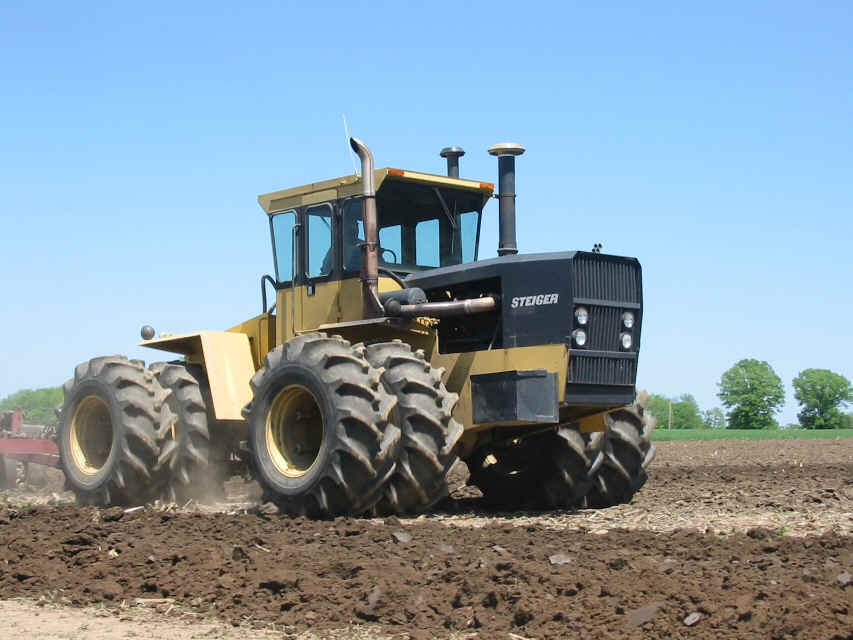
|
Steiger
Industrial Series
Years of Production: 1982-1984
Models:
Model CA or CU 280 (280 hp), Model CA or CU 325 or 360 (325/360 hp)
History:
In 1982 Steiger released a range of yellow tractors for industrial
applications in construction, mining, forestry and land leveling.
The Industrial tractors were based on the PTA Cougar and Panther
design. Steiger beefed up the axles, transmission and
hydraulic flow on the Industrial models. The model numbers
indicate the engine and horse power. Cummins powered the CU-280,
CU-325 and CU-360. The CA-280, CA-325 and CA-360 used Caterpillar
engines. Steiger also offered Agricultural models of the CA and CU
models for farming. The extra hydraulic power was well matched for
large plows, discs and field cultivators.
|
|
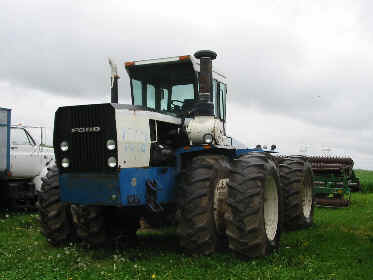
|
Steiger
built Ford FW Series
Years of Production: FW Series
1978-1982
Models:
FW 20 (210 hp) FW 30, (270
hp) FW 40 (295 hp) FW 60 (360 hp). FW 20 = Bearcat FW 30 = Cougar FW 40
= Cougar Fw 60 = Panther
History:
The 1970's was a changing time for the Farm Industry. Just twenty years
before a large farm tractor was 30-40 hp but by the end of the 1970's
300+ hp was an emerging tractor market that equipment manufactures were
selling and farmers were demanding for their growing operations. Ford
did not want to miss the boat and rather than going through the cost and
time of
engineering and testing a Ford 4wd tractor they looked to the
proven
market leader: Steiger. From 1978-1982 Steiger provided Ford with
a line
of 4wds from 210-360 hp. These Blue Steigers were sold as the 210
hp Ford FW-20, 270 hp FW-30, 295 hp FW-40 and the 360 hp FW-60. The Ford
FW-20 and 30 were dropped in 1980 in favor of the TW series front-wheel
assist models increasing sales. The Ford/Steiger relationship ended in
1982 as the North Dakota supplier began to run into finical troubles in
the sagging Ag economy. Ford began looking for a new option to provide
4wd power for their tractor line. That new opportunity would come five
years later when Ford purchased the Versatile Corporation. |
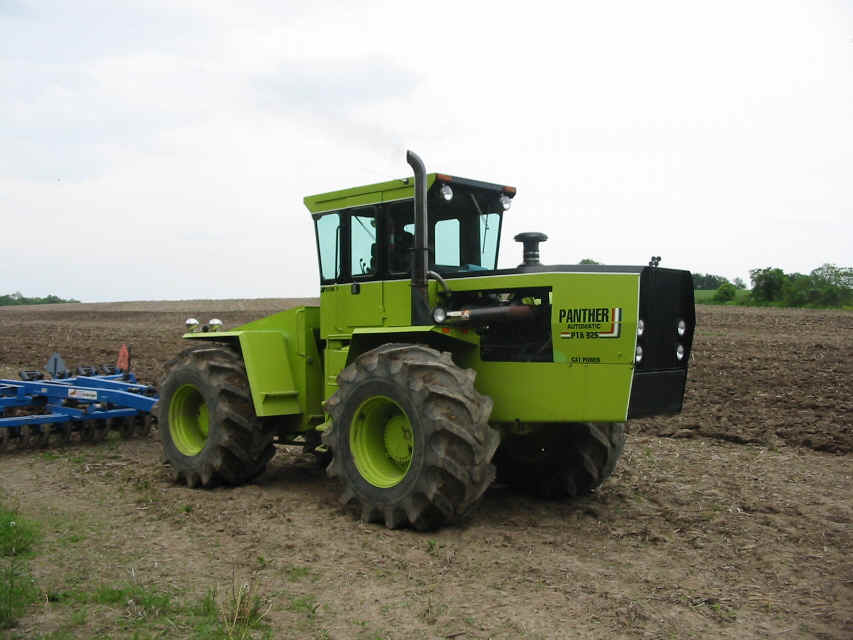 |
Steiger
Series III PT/PTA
Years of Production: PT Series
1977-1981/PTA Series 1978-1982
Models:
PT Bearcat (225 hp) PT-220, Cougar (250/270
hp) PT-250, PT-270, Panther (350 hp) PT-350. PTA
Cougar (251/270/280 hp) PTA-251, PTA-270, PTA-280, Panther
(296/297/310/325 hp) PTA-296, PTA-297, PTA-310, PTA-325.
History:
1977 brought additional advancement to the Steiger Series III with the
introduction of electronically controlled PTOs. The Bearcat,
Cougar and Panther were available with a limited 125 hp pto. The PT
prefix denoted the pto models. The PT Steigers have a longer hood
with a slight arch in the center.
In 1980 Steiger introduced an
automatic transmission series fitted with an electronically controlled
pto, called PTA. Cougar and Panther tractors were equipped with
the new feature. For example the PTA-325 Panther with Steiger-Matic assesses speed and load factors all by
itself, automatically maintaining the best gear for maximum power and
efficiency. In fact, Steiger-Matic actually locks into each gear to
provide a direct link between engine and axel, which gives the operator
the efficiency of manual transmission plus the convince of an automatic.
The Steiger's Caterpillar powered Panther was the heavy hitter of the
Steiger PTA line. As a fully automatic model it proved to be a and still
is one of the most popular Steigers.
|
|
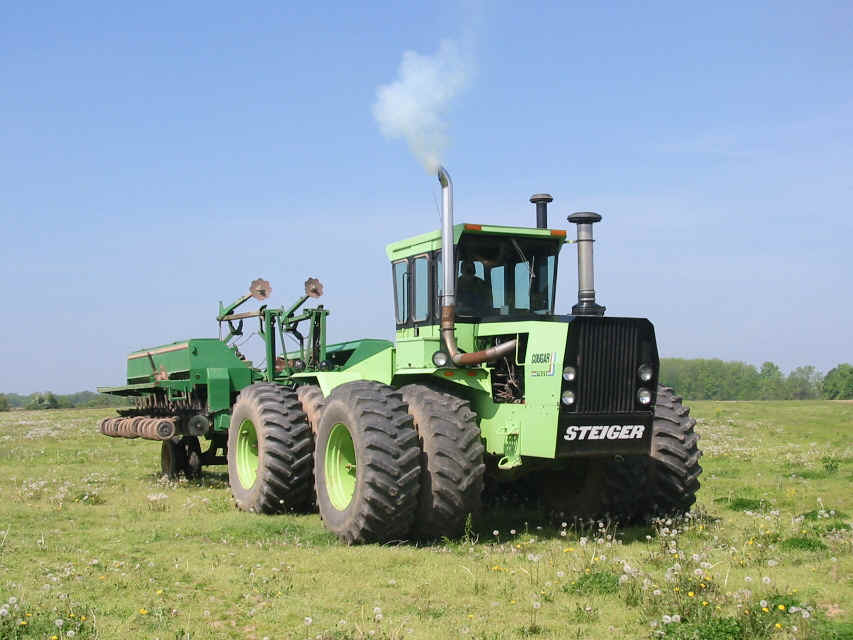
|
Steiger
Series III
Years of Production: 1976-1983
Models:
Wildcat (200 hp) ST-200, RC-200, Bearcat (220/225 hp) ST-220, ST-225,
Cougar (250/251/270/280 hp) ST-250, ST-251, ST-270, ST-280, Panther
(310/320/325/350 hp) ST-310, ST-320, ST-325, ST-350, Tiger
(450/470 hp) ST-450, ST-470.
History:
1976 ushered in a new generation of Steiger 4wds. The Series III
Steigers were introduced to dealers at the winter meeting in Florida.
A Circus theme was used complete with a lion tamer. As the new
tractor models were announced the lion tamer cracked his whip and the
new Wildcat, Bearcat, Cougar and Panther rolled out into the ring.
These new models offered both Caterpillar and Cummins engines with a 10
speed constant mesh transmission. The big change from Series II
was the all new Safari cab. The Safari offered a new level
of comfort and quite with easy to reach controls and improved visibility.
The Series I and II Steigers shift was in the center of the cab and the
hydrualic switch on the rear of the cab. The Series III cab made
operating the 4wd convenient and allowed the operator to sit in air conditioning
and the power do the work. In 1977 Steiger increased the series
power to include the 450 and 470 hp Tiger models. The Series III
Steiger 4wds captured 36% of the North American 4wd market.
|
|
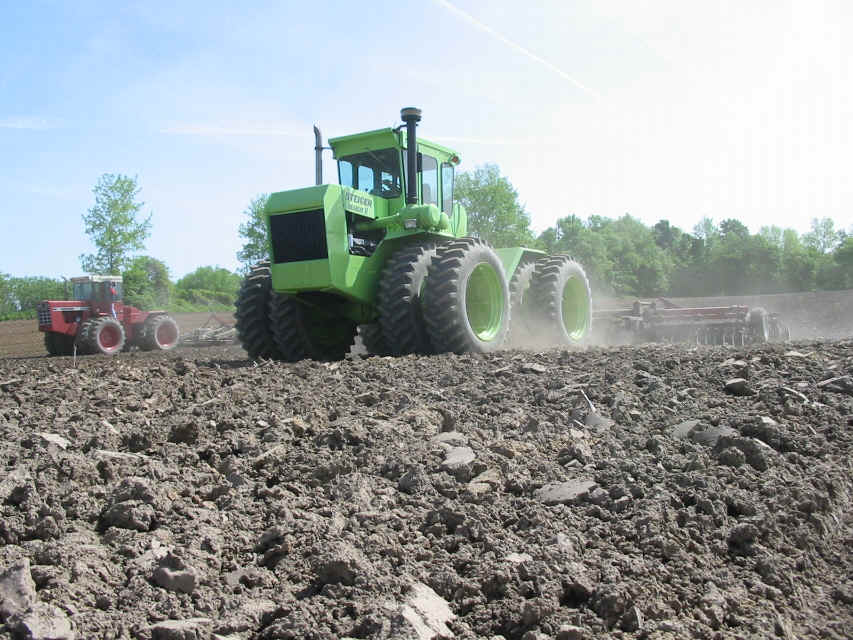
|
Steiger
Series II
Years of Production: 1974-1976
Models:
Super Wildcat (200 hp) ST-200, RC-200, Bearcat (225 hp) ST-225, RC-225,
Cougar (300 hp) ST-300, Panther (310 hp) ST-310, Turbo Tiger (320 hp)
ST-320.
History:
In 1974 Steiger broke ground on a new factory. In less than a year
the new 420,000 square foot manufacturing facility was finished.
It employed 1,100 people and could produce a new Steiger 4wd every 18
minutes. This plant is owned by Case-New Holland today and
produces the CaseIH STX Steiger 4wd line, Case/New Holland Wheel
Loaders, the New Holland TJ 4wd line and TV 145 bi-directional
tractor. In 1974 the new Fargo plant began producing the Steiger
Series II 4wds. Steiger Series II 4wds were basically the same in
as far as tin work and features. Steiger changed the paint scheme from
green and red to a green frame and wheels and a black grill, hood and
cab. The CAT engine was also painted black. The Panther was
added to the line. Steiger also began offering the Wildcat and Bearcat
available in standard and row crop. The Series II Steigers were
denoted with the prefix ST for standard models and RC for row crop
models in front of the horse power. For example the Panther II was
the ST-310 (Standard 310 hp) and the Bearcat II could be the ST-225
(Standard 225 hp) or RC-225 ( Row Crop 225 hp).
|
|
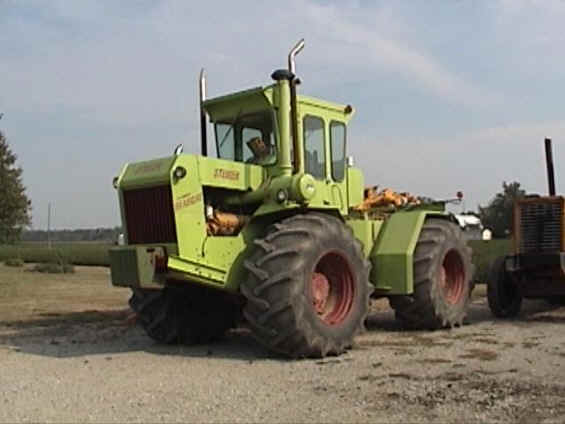
|
Steiger
Series I
Years of Production: 1969-1974
Models:
Wildcat (175 hp), Super Wildcat (200 hp), Bearcat (225 hp), Cougar (300
hp), Tiger (310 hp), Turbo Tiger (320 hp).
History:
The Steiger brand 4wds quickly grew in popularity with farmers in the
plains. Selling 4wds beyond that region, proved to be
difficult. Salesman Earl Christianson saw 200 hp machines working
on construction sites and watched 90 hp-50 hp 2wd tractors struggling n
farmland. Why not big horse power on the farm? Earl joined the
Steiger brothers in the 1960s and greatly expanded their sales
region. Steiger grew beyond the barn and an investor group
purchased the company to expand and improve its product range. In
1969 Steiger opened a new production facility in Fargo, North
Dakota. The Wildcat was the first Steiger to roll out of the
factory. Steiger replaced the numbered models with the famous cat
names that marked the 4wd line horse power range for two
decades. The Series I Steigers offered a new refined chassis,
tin work, a climatized cab mounted independently from the tractor frame
and a 10/2 transmission. The Series I tractors continued using
Steiger green on the frame and red on the grill and wheels. All of
the tractors used Caterpillar engines and they were left in standard CAT
yellow. In 1970 sixty-six dealerships took on Steiger. Series I
Steigers were sold in new markets from coast to coast. In
the South to rice farmers in Arkansas, Louisiana and Oklahoma were
quick to add 4wds to their operation. On the East Coast in New
York, Pennsylvania, Maryland, Delaware and North Carolina cash crop and
dairy farmers used Steigers to plow their land like never before. On the
West Coast large vegetable farmers in California, grass seed farmers in
Oregon and hillside wheat farmers in Washington added the 4wds to their
operations.
|
|
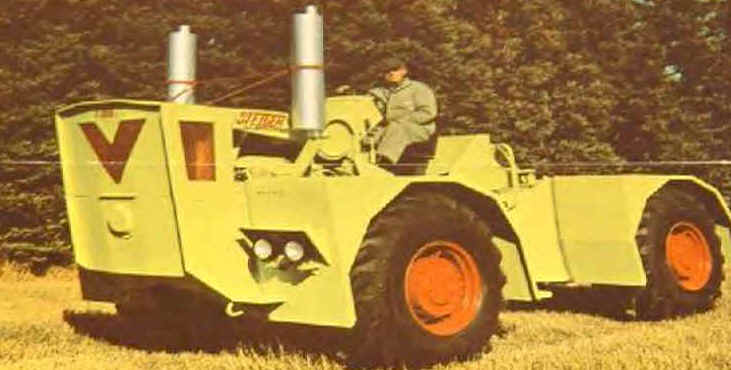
|
Barn Series
Years of Production: 1963-1969
Models: 1250
(150 hp), 1700 (216 hp), 2200 (238 hp) 3300 (328 hp) 800 Tiger (300 hp).
History:
Steiger #1 won local fame in the Red River Falls region. Local
farms were so impressed by the Steiger that they asked the brothers to
build 4wds for their farms. In the early 1960's the brothers began
producing a 118 hp 4wd similar to the #1 called the 1200. In 1963
the brothers began to design and build a series of tractors on their
farm. These second generation Barn Series 4wds were distinct with
a large V cut in the front of the tractor to create a grill. 126
of the Barn Series 4wds were produced and sold in the Northern Plains
States and Canadian Provinces. |
|
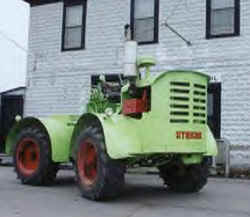
|
Early
History: Barney Steiger #1
Douglas and Maurice
Steiger were successful farmers in Thief River Falls Minnesota.
During the 1950's they found that as their farm grew they needed to
cover the ground faster and more efficiently. Tractors of the time were
2wd and offered 50-60 hp in top range models. The brothers built
their first tractor during the winter of 1957-58. Steiger #1 was
built using surplus parts from the farm and a local quarry's
earthmover and truck components. Steiger green also came from the
quarry. The equipment at the quarry was painted a lime green and
the brothers used the paint on their articulated 4wd. The brothers
chose to power the 15,000 lb tractor with a 238 hp V6 Detroit Diesel 71 diesel
engine. The tractor was built in the Steiger's dairy barn and was
nick named Barney. It went on to work over 10,000 hours in the
field. Today it resides in West Fargo, North Dakota at the
Bonanzaville Museum. Visit the museum at http://www.bonanzaville.com
|
Photographs from Steiger Sales Literature
for Identification Purposes, from Jason Hasert, Peter Simpson, Jason
Faulkner, Steve VonDeylen and John Schomberg. These pictures may not be copied
from Big Tractor Power.com
 Back to BigTractorPower.com's CNH
4wd History
Back to BigTractorPower.com's CNH
4wd History

|